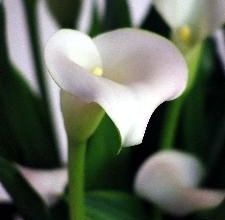Calla lilies, or Zantedeschia, are flowering plants native to Africa. The genus was named after Giovanni Zantedeschi, an Italian doctor and botanist. Despite being called lilies, callas are actually members of the Arum rather than the Lilium family, so they are not true lilies, but are more closely related to species such as caladiums and jack-in-the pulpits. They work well as cut flowers, in water gardens or as container plants, according to Dr. Leonard Perry from the University of Vermont.
Identification
-
Calla lilies grow around 2 or 3 feet tall with an approximate 2-foot spread. They have an upright, clumping form with long, arrow-shaped leaves that grow from the base of the plant on leafless stalks. The foliage varies in color depending on the species and cultivar. The plants produce large, trumpet-shaped, flower-like plant structures called spathes that range from solid white to pink or purple, depending on the variety. The spathe, which is actually a modified leaf, wraps around a yellow plant part called a spadix. The spadix contains the flower’s true but minuscule blossoms.
Species and Cultivars
-
According to Dr. Perry, the Zantedeschia genus contains six species, but only four of those are commonly grown in gardens around the world. The elliottiana variety has 18-inch-long green leaves and 6-inch-long flowers, while the albomaculata variety bears 5-inch light yellow, pink or white flowers with purple markings inside the flower. Rehmanii produces 5-inch-long deep purple or white flowers, while aethiopica yields 10-inch white blossoms with 16-inch green leaves. Several hybrid cultivars include Little Suzy, which produces speckled foliage and pink flowers; Green Goddess, which has green flowers with white centers; and Cameo, which has peach-colored blossoms.
Cultivation
-
Calla lilies are hardy in United States Department of Agriculture hardiness zones 9 and 10. They prefer nutrient-rich, organic soil and thrive in wet, boggy or alkaline soil. They grow in either full sun or light shade. Plant calla lily tubers or rhizomes in the fall or spring. Space plants between 1 and 2 feet apart and plant the rhizomes at a depth of around 4 to 6 inches deep. Fertilize the soil using a 5-10-10 or a 5-10-5 fertilizer. They bloom around the end of spring or the beginning of summer. Dig up the rhizomes at the end of the growing season and store them in a cool, dry place for replanting the following season.
Problems
-
Insects such as mealybugs, aphids and mites are common problems on calla lily plantings. Mealybugs are around a third of an inch long; they have soft bodies covered in powdery white wax. Aphids are soft-bodied insects that vary in size from 1/25 to 1/8 inches in length, while mites are too small to see without magnification. These pests suck plant fluid from calla lilies. Calla lilies have few diseases, but a bacterial soft rot called Erwinia may damage the rhizomes.


Deprecated: strpos(): Passing null to parameter #1 ($haystack) of type string is deprecated in /home/agriviek8Qv/agriviet.net/public_html/wp-includes/comment-template.php on line 2522